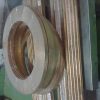
Ammonia is an important raw material for the production of nitric acid, ammonium salts and amines. Ammonia is a gas at room temperature and can be liquefied under pressure. Most metals such as stainless steel, aluminum, magnesium and titanium, with the exception of copper and other copper alloys, have excellent corrosion resistance to ammonia gas, liquid ammonia and aqueous ammonia.
Zinc alloys such as copper-navy brass and aluminum brass are most susceptible to stress corrosion cracking (NH3SCC) due to the copper alloy ammonia. Ammonia stress corrosion cracking of copper alloy heat exchanger tubes is due to surface cracking, green/light blue Cu-ammonia corrosion complexes (compounds), and intra- or intragranular single or highly branched cracks at the tube surface. Characterized by formation, it depends on environment and stress level. Liquid ammonia stress corrosion forms when the medium simultaneously meets the following conditions:
Situations where liquid ammonia (water content <0.2%) can be contaminated by air (oxygen or carbon dioxide).
The working temperature is higher than -5℃.
In fact, other oxidants such as oxygen and water are important conditions for stress corrosion of copper. Due to impurities in crude oil and additives in the processing process, there are many potential corrosion factors in oil refining. The types of crack corrosion caused by ammonia include:
H2S-NH3-H2O corrosion
This is largely determined by the concentration, flow rate and characteristics of the medium. The higher the concentration of NH3 and H2S, the more severe the corrosion. The higher the flow rate of fluid in the tube, the stronger the corrosion. Low flow rates cause ammonium salt deposition and localized corrosion. Some media, such as cyanide, exacerbate corrosion, and oxygen (which comes in with injected water) accelerates corrosion.
Ammonia corrosion at the top of the alkyl sulfate column
Alkaline scrubbing and scrubbing reactor products are very important to remove acidic impurities to control excessive corrosion of the column top system in the fractionation section. Precedents of neutralizing and film-forming amine inhibitors have sometimes been used in tower top systems. Neutralizing the amine or NH3 neutralizes the condensed water at the top of the column to pH 6-7 to reduce corrosion rates and minimize the amount of inhibitor used. ..
Catalytic reforming ammonia corrosion
Catalytic reformers have several types of stress corrosion cracking, three of which are ammonia stress corrosion cracking. NHXNUMX is present in the effluent of pretreatment and reforming reactors and dissolves in water to form ammonia, which causes rapid stress corrosion cracking of copper-based alloys.
Ammonia corrosion of delayed coking unit
The equipment of the delayed coking unit is susceptible to low temperature corrosion mechanisms such as ammonia-induced stress cracking of copper-based alloys. These corrosion mechanisms play a role in the processes of water quenching, steam coke cleaning and deaeration. However, all coking towers are usually equipped with vent pipes and blowdown tanks, so they are almost always exposed to wet vent vapors and liquids.
Quench and vent vapors and liquids typically contain large amounts of H2S, NH3, NH4Cl, NH4HS, and cyanide, which are released from the pyrolysis reaction of the feedstock into the coking plant. Due to the presence of NH3 in the caulking unit, ammonia causes stress corrosion cracking in high pH copper alloy tubes.
Ammonia corrosion of sulfur recovery equipment
The gas supply is usually rich in H2S and saturated steam and may mix with the hydrocarbons and amines that cause H to penetrate into the metal, resulting in hydrogen-induced cracks (including hydrogen bulging) and sulfide stress. Crack (SSC) gas supply. In addition, the gas supply may contain NH3, which can cause stress corrosion cracking caused by NH3, and cyanide can also accelerate corrosion rates.
Reducing the Zn mass fraction below 15% improves the corrosion resistance of Cu-Zn alloys. SCC in a vapor environment may be controlled by preventing air ingress. The sensitivity of copper alloys is generally evaluated by examining and monitoring PH values for water samples and NH3. Eddy’s current or visual inspection can be used to determine cracks in the heat exchanger bundle. In short, copper and its alloys should be avoided in production processes involving ammonia and liquid ammonia.






